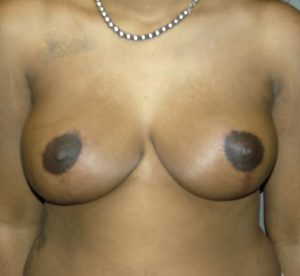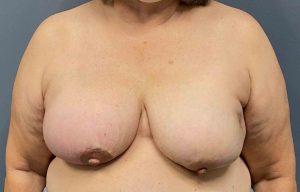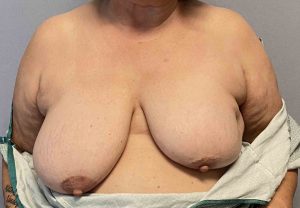
In breast asymmetry, where one breast has a good shape and size and the abnormal breast is larger, breast reduction techniques can be used for a better size match. Almost always this means not only is the larger breast size reduced but the nipple is positioned higher and smaller as well for symmetry improvement.
In breasts that have been treated for cancer breast asymmetry is going to result, particularly if some surgical excision of the tumor has been performed. This is especially seen when lumpectomies are performed which is often followed by radiation treatments. While effective at curing the cancer a breast deformity is going to result compared to the opposite unaffected side.
Case Study: This older female had a prior left breast lumpectomy followed by radiation to treat breast cancer. This resulted in a smaller more contracted breast shape compared to the much larger unaffected right side. Her primary concern was to have breasts in which she could wear a bra in which both breasts would fit. On the left breast she has two very hard contracted areas in the upper and loper poles which was uncomfortable.
Under general anesthesia the right breast was treated with a reduction technique that maintained the ptosis shape of the left breast while making its size smaller. The left breast was treated by fat injections into the contracted lumpectomy defects.

In the irradiated breast the tissues are not normal. It may look fine but when exposed to surgical trauma the risks of delayed or even non-healing of the tissues exists. Thus any surgical approaches to the irradiated breast should be approach with extreme caution. Fat injections into the irradiated breast is known to improve its healing capabilities but considering an extensive breast lift in an irradiated breast is still a precarious undertaking. Which is why in this patient the irradiated breast was treated with fat injections only for the purpose of scar softening and improved comfort. Its sagging shape is to be maintained.
In reducing the larger breast to match the smaller one, so a bra could be worn more comfortably, the primary goal is a better size match. Typically this would mean a breast reduction is which the nipple is also elevated and placed in the center of the. reduced, lifted and now non-sagging breast. In her case keeping the sagging shape in the reduced breast was chosen to best optimize the size reduction and improve symmetry. This is not how the usual breast reduction is designed and performed and resulted in the need for a modified reduction approach to keep a sagging or ptotic breast shape.
Case Highlights:
1)When breast reduction is done on one breast for asymmetry the goal is to match the opposite side.
2) In breasts that have been irradiated due to cancer reshaping surgery that involves extensive cutting and skin undermining is risky due to potential non-healing concerns.
3) In the irradiated smaller breast that has ptosis with a larger opposite breast, the larger breast can be reshaped to mimic the ptosis that the irradiated breast has.
Dr. Barry Eppley
Indianapolis, Indiana





